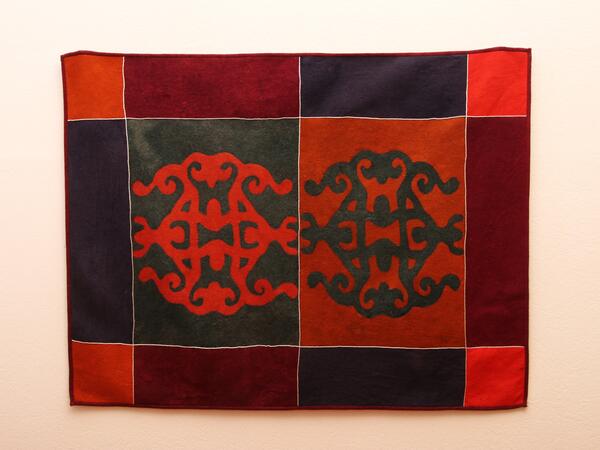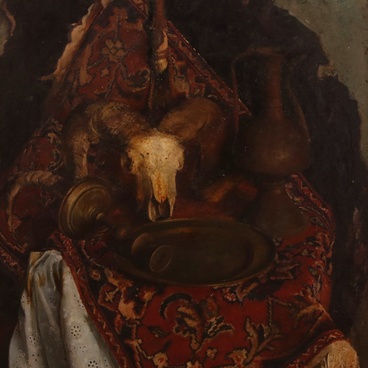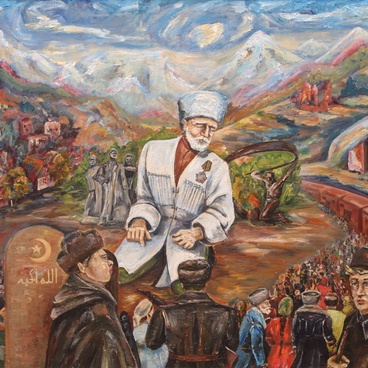The museum houses an artwork created by craftswoman Raishat Akhilgova. ‘Isting’ is a traditional ornamental felt rug.
Such carpets played an important role in the culture and life of the Ingush. They were not used simply as household items: single-colored felt carpets lay on the floor but the istings were hung on the walls or used for rituals. Felt products with symbols of the family were part of the bride’s dowry. On the wedding day, before the daughter-in-law was introduced to the new house, a piece of felt with a broom were placed at the doorstep: they symbolized the wish for a prosperous life. In honor of a newborn child, rugs with embroidered amulets were gifted. On the day of the funeral, the person’s body was carried out on a felt carpet.
Ornaments often carried symbolic information, conveyed sorrow or joy. If people in neighboring auls (villages) received from a messenger a carpet with a symmetrical ornament, this meant happiness and prosperity. When disasters occurred, the ornament was made asymmetrical.
The process of creating such carpet is quite laborious: the wool is washed, dried, combed, and then felted by hand. The wool from the back of a sheep was considered the best for istings, as it is clean and long. An ornament is cut out of the finished felt and dyed in different colors. When these pieces are dried, they are trimmed and sewn in even, periodic stitches. Often the ornaments were framed with a thick white cotton cord.
The color of the carpet depended on the place of its manufacture and the pigments available in the area. In the ancient times, craftswomen used natural colors of wool — white, gray, brown, black. Later they began to dye felt. A tobacco color was obtained from walnuts, barberry roots were boiled to get an orange dye. Depending on the boiling time, red and brown pigments could also be obtained from barberry. Craftswomen also could use a decoction of oak bark, green walnut shells, onion husks, and even insects. However, in the second half of the 19th century aniline dyes gradually replaced the natural ones.
Presently, in the Republic of Ingushetia, only a few craftswomen know how to make the felt carpet. One of them is Raishat Akhilgova. Her works regularly appear at exhibitions in the Republic and abroad. The artist’s collection contains more than 20 istings of various shapes, textures, and colors. Among them, are carpets with traditional family ornaments recreated from old family photographs.
Such carpets played an important role in the culture and life of the Ingush. They were not used simply as household items: single-colored felt carpets lay on the floor but the istings were hung on the walls or used for rituals. Felt products with symbols of the family were part of the bride’s dowry. On the wedding day, before the daughter-in-law was introduced to the new house, a piece of felt with a broom were placed at the doorstep: they symbolized the wish for a prosperous life. In honor of a newborn child, rugs with embroidered amulets were gifted. On the day of the funeral, the person’s body was carried out on a felt carpet.
Ornaments often carried symbolic information, conveyed sorrow or joy. If people in neighboring auls (villages) received from a messenger a carpet with a symmetrical ornament, this meant happiness and prosperity. When disasters occurred, the ornament was made asymmetrical.
The process of creating such carpet is quite laborious: the wool is washed, dried, combed, and then felted by hand. The wool from the back of a sheep was considered the best for istings, as it is clean and long. An ornament is cut out of the finished felt and dyed in different colors. When these pieces are dried, they are trimmed and sewn in even, periodic stitches. Often the ornaments were framed with a thick white cotton cord.
The color of the carpet depended on the place of its manufacture and the pigments available in the area. In the ancient times, craftswomen used natural colors of wool — white, gray, brown, black. Later they began to dye felt. A tobacco color was obtained from walnuts, barberry roots were boiled to get an orange dye. Depending on the boiling time, red and brown pigments could also be obtained from barberry. Craftswomen also could use a decoction of oak bark, green walnut shells, onion husks, and even insects. However, in the second half of the 19th century aniline dyes gradually replaced the natural ones.
Presently, in the Republic of Ingushetia, only a few craftswomen know how to make the felt carpet. One of them is Raishat Akhilgova. Her works regularly appear at exhibitions in the Republic and abroad. The artist’s collection contains more than 20 istings of various shapes, textures, and colors. Among them, are carpets with traditional family ornaments recreated from old family photographs.



